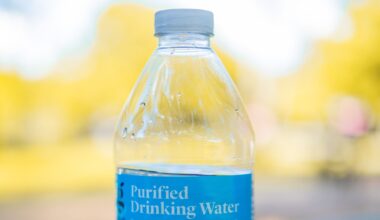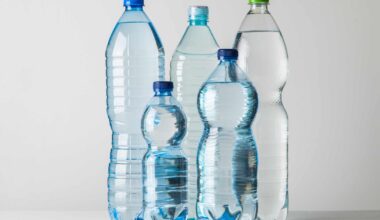Ever watched your fur buddy fascinated by a water bottle? You might wonder, “What’s so enchanting about a plastic container?” Well, let’s dive into the intriguing canine world to discover the allure of water bottles for our four-legged friends.
“Dogs are not just our pets; they’re confounding conundrums wrapped in fur.”
From their baffling sleeping positions to their obsession with the simplest of objects, our canine companions never cease to amaze and amuse us. Today’s curiosity – why do dogs like water bottles?
Join us as we unravel this puppy mystery and you might just find yourself viewing your water bottle in a whole new light!
The secret behind a dog’s fascination with water bottles
Have you ever tossed a water bottle, only to find your furry pal scurrying about, all eager to pounce on it? It’s not just your dog – many pooches share this peculiar fascination with water bottles too! Let’s unravel this intriguing canine mystery together.
The Crunch Factor: First up, let’s talk about what I like to call the ‘Crunch Factor’. It’s the satisfying crunch sound that a water bottle makes under a dog’s mighty jaws. Dogs find this sound stimulating and it triggers their prey instinct, giving them an adrenaline rush.
- The Sound & Feel: Dogs have an acute sense of hearing. The crinkling sound that a water bottle makes imitates the noise small prey would make in the wild. This sound, combined with the texture of the bottle, appeals to their primal instincts.
- The Chase: Dogs love to play, and a moving water bottle can provide endless fun. It’s light, it bounces unpredictably, and it rolls around – all the elements of an exciting chase!
Is it safe for dogs to play with water bottles? Many owners wonder if allowing their dogs to play with water bottles is safe. While it can be ok under supervision, it’s important to ensure that your dog doesn’t swallow any plastic pieces that could lead to choking or internal blockages.
| Safe Play | Risky Play |
|---|---|
| Supervised play | Unsupervised play |
| Removing the cap and label | Leaving the cap and label on |
| Replacing the bottle when it gets too damaged | Not replacing the bottle even when it’s damaged |
In conclusion, while dogs certainly enjoy the antics of a water bottle, it’s important for owners to ensure their playtime is safe. So, next time you’re about to toss an empty bottle into the recycling bin, think twice – you might just be throwing away your dog’s new favorite toy!
What makes a water bottle so intriguing to dogs?
Ever caught your furry buddy playing with a water bottle, and wondered what’s the intrigue? It’s as if they’ve discovered a priceless artifact instead of a piece of recyclable plastic! Hold on to your paws folks, because we’re about to dive deep into the canine psyche.
The Crunch Factor:
From your dog’s point of view, the crunchy sound a water bottle makes can be immensely satisfying. It’s akin to the noise they’d hear while hunting, like bones crunching or underbrush rustling. This taps into their primal instincts, making a simple water bottle a thrilling toy.
The Element of Surprise:
Water bottles are unpredictable. One moment they’re quiet and stationary, the next they’re noisily skittering across the floor. This unpredictability keeps dogs engaged and provides mental stimulation that many toys fail to deliver.
It’s a Challenge:
A water bottle isn’t an easy adversary. It slips, slides, and refuses to stay still. To a dog, this presents a fun challenge, and a victorious catch is a triumph to be savored!
The Chew Factor:
To top it all off, the chewy nature of plastic offers a satisfying texture for dogs. Much like a chew toy, a water bottle can provide hours of gnawing fun.
So there you have it, you’ve just peeked into the world from a dog’s perspective! Next time you see your furry friend chasing a water bottle, you’ll know they’re not just playing—they’re on a thrilling, noisy, unpredictable adventure.
The science behind dogs and their love for water bottles
Ever wonder why your beloved furry friend is head over heels in love with that humble water bottle? Well, it’s because they’re naturally curious and playful creatures who love to explore the world around them. Plus, the crunching sound a water bottle makes is music to their ears!
The Crunch Factor
Simply put, dogs love the crinkly, crunchy sound that a water bottle makes. It reminds them of the sound that prey makes in the wild, stimulating their predatory instincts. Plus, it’s just plain fun!
Textural Attraction
Then, there’s the texture. Dogs have a sense of touch that’s far more developed than ours. The unique feel of a plastic water bottle gives them a novel sensory experience every time they sink their teeth into it.
- A plastic bottle’s texture is unlike anything else in a dog’s playtime repertoire.
- The crunch and give of the bottle is satisfying for a dog’s powerful jaws.
Filled with surprises
Finally, there’s the element of surprise. A water bottle can roll unpredictably, bounce in an exciting way, or even give off a little squirt of water. This can lead to hours of fun for your four-legged friend!
It’s like a doggie game of roulette, you never know what you’re going to get.
So there you have it – a tiny glimpse into the science of why dogs are enamored with water bottles. The next time you see your pooch joyfully gnawing on one, you’ll know it’s not just a quirky habit, but a delightful mix of instinct, sensory pleasure, and the thrill of unpredictability.
Why do some dogs prefer water bottles over toys?
Ever had that moment when you buy your furry friend the most elaborate, expensive toy and they end up frolicking with an empty water bottle? It’s not just your dog’s personal quirk, believe it or not, there’s a method in this bottle-loving madness!
Sound, Texture, and Play
First off, dogs are sensory creatures with a finely tuned sense of hearing. The crunch and crackle of an empty water bottle are like a symphony to their ears, providing auditory satisfaction that most toys can’t match.
Next, there’s the feel of the bottle. The smooth, hard texture offers a different tactile experience compared to the usual soft, plush toys. It’s exciting, it’s fresh, and it’s a welcome change for our canine companions.
Plus, the unpredictable bounce of a water bottle during a game of fetch can be far more thrilling than a predictable, straight-line trajectory of a standard toy.
The Safety Aspect
Before you start hoarding water bottles as canine entertainment, a word of caution: always supervise your dogs when they’re playing with these. Bits of plastic can break off, posing a choking hazard or causing internal damage if swallowed.
Consider investing in toys designed to hold water bottles. These provide the same crunchy goodness, but with an added layer of protection. Keep the cap, ring, and label away from your dog to ensure safe play.
And there you have it! Our dogs aren’t just being weird or frugal – they have some very good reasons for their bottle obsession. Who knew something so simple could bring so much joy?
The evolutionary reasons for a dog’s attraction to water bottles
Ever wondered why your dog seems to have a particular fondness for your water bottles? It’s a question that has puzzled many a pet parent. The truth is, there’s an intriguing evolutionary backstory to this seemingly odd behavior.
The roots of this attraction can be traced back to our canine friends’ wild ancestors. These wild dogs, wolves, had to be resourceful in order to survive, and they would frequently use items found in their environment as tools or playthings. This trait has been passed down to our domestic dogs, hence their affinity for objects like water bottles.
A Bottle’s Satisfying Crunch
The crunching noise a water bottle makes when a dog chews on it closely mimics the sound of bones being crushed – a sound that wild dogs associated with feeding time. This is why your dog might seem to derive a great deal of satisfaction from crunching on a water bottle! It’s like a little echo from their wild past.
Water Bottles are Versatile Toys
Besides their satisfying crunch, water bottles also roll, bounce and can be carried around easily – characteristics that make them fun and versatile toys for dogs. The unpredictable nature of a rolling, bouncing bottle can provide endless entertainment and mental stimulation for your pup.
The Taste and Smell of Humans
Moreover, water bottles often carry the scent and taste of their human owners, which dogs find comforting and appealing. This is another reason why your dog might be so fascinated with your water bottle – to them, it’s not just a plaything, but a familiar, comforting object.
So, the next time you find your dog playing with a water bottle, you’ll know it’s not just a random obsession. It’s a fascinating blend of instinct, playfulness, and their special bond with you.
Training your dog to enjoy water bottles in a safe way
Let’s dive into the fun, splashy world of training your dog to enjoy water bottles responsibly, shall we? Remember, safety first! Dogs are like furry, four-legged toddlers, and it’s our job to ensure their playtime doesn’t end in a trip to the vet’s office.
Step 1: Choose the Right Bottle
- Begin with a bottle that’s sturdy and big enough to avoid being a choking hazard. Plastic water bottles can be a great option, but steer clear of glass or thin plastic that could easily break and harm your pup.
- Ensure the lid is securely fastened. No one wants a thirsty dog getting a surprise mouthful of old water!
Step 2: Introduce the Bottle
- Next, let your dog inspect the bottle. This isn’t a stealth mission – let them sniff, paw, and play under close supervision.
- If they seem apprehensive, place the bottle among their favorite toys or near their bed to create a positive association.
Step 3: Make it a Game
- Who said training had to be boring? Make the water bottle a star player in your next game of fetch or hide-and-seek.
- Remember, the goal is to make your dog see the water bottle as a fun, safe toy – not a chew snack!
Pro Tip: Supervise your dog’s playtime carefully. If the bottle shows signs of wear and tear, replace it with a new one.
Training your dog to enjoy water bottles in a safe way can seem like a daunting task. But with patience, consistency, and a healthy dash of fun, you’ll soon have a happy, hydrated hound. Remember, the journey is just as important as the destination!
The potential dangers of dogs playing with water bottles
It’s hard to dispute the joy a plastic water bottle can bring to our furry friends. That crunchy sound, the cap they can chase for hours, it’s pure bliss! However, this seemingly harmless plaything could potentially turn into a dangerous hazard.
Choking Hazards
The small pieces that break off from a chewed water bottle can be easily swallowed by your pet. This can lead to choking or digestive blockages, both of which can be life-threatening.
Sharp Edges
As dogs gnaw on the bottle, their powerful jaws can create sharp, jagged edges. These can inadvertently cause injuries to the mouth, gums, or tongue.
Toxicity Risks
Plastic bottles often contain harmful chemicals. While these chemicals may not be harmful in small amounts, long-term exposure can be detrimental to your dog’s health.
Remember, not all playthings are created equal. Always ensure your dog’s toys are pet-friendly and safe for chewing.
So, next time your pup eyes that discarded water bottle, maybe offer a tennis ball instead. It’s a safer, and just as entertaining, alternative!
Common behavioral problems associated with dogs and water bottles
If you’re a pup parent, you’ve probably noticed your fur baby’s strange fascination with water bottles. It may seem odd, but it’s quite common and can sometimes lead to behavioral issues. Let’s dive into this peculiar pooch phenomenon.
The Crinkle and Crunch Factor
Dogs are naturally curious creatures. The distinct sound a water bottle makes when squished, often known as the ‘crinkle and crunch’, can be irresistible to our four-legged friends. This auditory stimulation can be highly engaging, but it can also lead to a dog’s obsession with water bottles.
Chew Toy Substitute
Water bottles may also serve as a substitute for chew toys, especially for pups with a strong urge to gnaw. The problem? They can easily break into sharp pieces, causing injury. Plus, they aren’t exactly designed with a dog’s dental health in mind.
Attention-Seeking Behavior
Some dogs use water bottles as a tool to get your attention. If they’ve noticed you react (whether positively or negatively) to their water bottle play, it may encourage them to repeat the behavior.
- Tip: If you think your dog is using water bottles for attention, try ignoring the behavior. If they realize it’s not getting your attention, they might stop.
Resources Guarding
Lastly, water bottles can sometimes trigger resource guarding behavior in dogs. This is when a dog becomes overly protective of what they consider to be a valuable resource. In this case, the fascinating, crunchy water bottle!
“Understanding your dog’s behavior is the first step to managing it. If your dog exhibits any problematic behavior with water bottles, it’s always best to consult with a professional.”
In conclusion, while a dog’s fascination with water bottles can be cute and entertaining, it’s important to ensure it doesn’t lead to any harmful behaviors. Always prioritize your dog’s safety and wellbeing when it comes to playtime!
Alternatives to water bottles: other toys that dogs love
Who said that a dog’s happiness is solely confined to water bottles? There are plenty of other toys that can equally tickle their fancy. Let’s dive into a few alternatives that can get those tails wagging with joy.
The Ever-Classic Tennis Ball
Fetch! It’s a command that delights every dog and usually, at the heart of this joy, is the traditional tennis ball. It’s bouncy, it’s bright, and it’s perfectly mouth-sized for your furry friend to catch mid-air.
Plush Toys
All dogs, irrespective of their size, seem to have a soft spot for plush toys. These soft, cuddly items can provide comfort, stimulate their minds, and satisfy their intrinsic hunting instincts.
Squeaky Rubber Toys
For the auditory dog who loves a good ‘squeak,’ these rubber toys can provide hours of fun. They are durable, easy to clean, and the weird sounds they produce can be music to a dog’s ears.
Chew Toys
Chew toys come in all shapes and sizes, catering to the natural need for dogs to gnaw. Not only do they provide a fun activity, but they also promote dental health by cleaning their teeth and massaging their gums.
Remember, no toy can replace the companionship and love that you offer your pet. So, the best toy you can give your dog is your time and attention.
Understanding your dog’s individual preferences and personality traits
Just like people, every dog has its own set of likes and dislikes. Some might be intrigued by the rustling sound of a water bottle, while others may be interested in its shape or texture. Understanding your dog’s individual preferences and personality traits can provide insight into why your canine friend might be so interested in your water bottle.
Personality Traits:
- Curiosity: Dogs are naturally curious creatures. If something new, like a water bottle, enters their environment, their interest might be piqued.
- Playfulness: Dogs love to play! A water bottle can be a fun toy, especially if it makes noise when squeezed or rolled.
- Teething: For puppies, chewing on a water bottle can help alleviate the discomfort of teething.
Preferences:
- Texture: The smooth, cool surface of a water bottle might feel good on your dog’s gums and teeth.
- Size: Water bottles are often the perfect size for a dog to hold in its mouth and carry around.
- Noise: The crunching sound a water bottle makes can be entertaining for a dog.
Remember, while it’s important to understand your dog’s personality and preferences, it’s equally important to ensure their safety. Always supervise your pooch when they’re playing with a water bottle and remove any small, detachable parts that could become a choking hazard.






